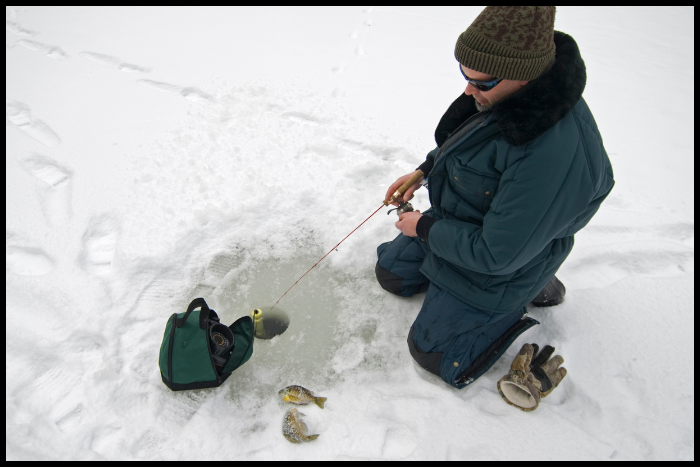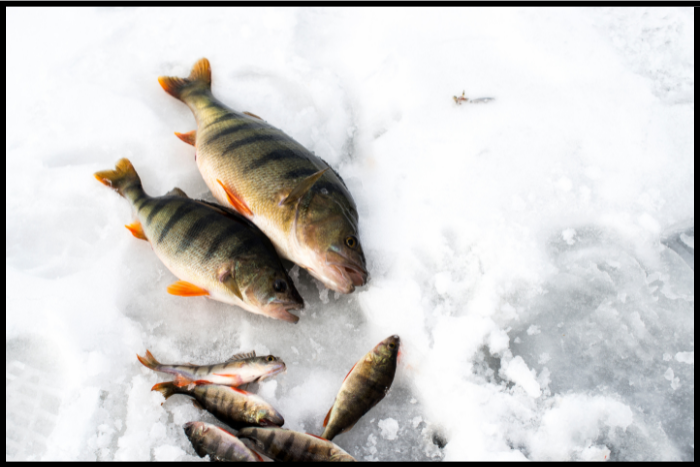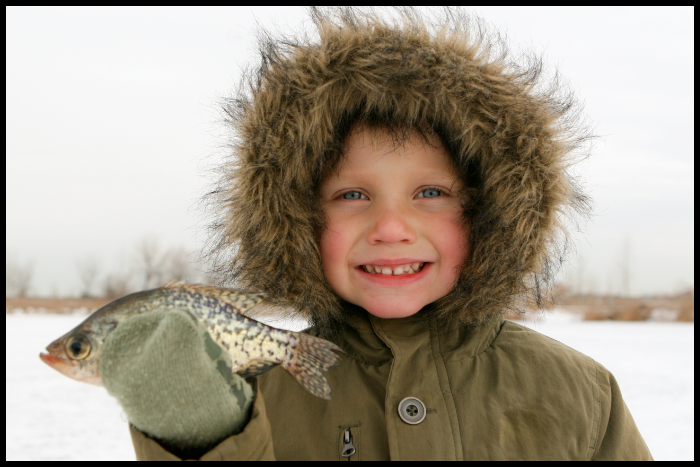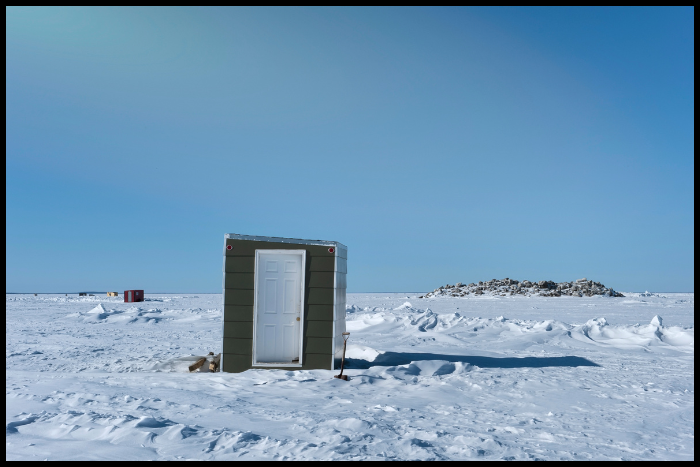Ice fishing isn’t for the faint of heart, regardless of the temperature. You’re heading out in cold temperatures, drilling holes through inches of ice, and doing your best to stay comfortable in below-freezing temperatures. While the reward is worth the effort, it’s not always easy, especially on those shockingly cold days.
Depending on the quality of gear you own and your willingness to endure frigid weather, there isn’t a temperature that’s too cold for ice fishing. However, bites can slow when temperatures get below zero, and spending time outside your ice house becomes dangerous. Understanding your limits is vital.
Cold weather is inevitable when you’re ice fishing, so as long as you’re prepared and know its dangers, you can fish safely in most conditions. My ice fishing survival guide will help you with that!
Understanding Ice Fishing Air Temperatures to Survive
When temperatures dip below 32 °F, water temperatures cool, and ice starts forming on ponds, lakes, and rivers.
At this point, anglers start getting their ice fishing gear prepped and ready for the season. My article on ice fishing gear list will help you remember all the essentials you need to pack for ice fishing.
1. Teens, Twenties, Thirties
The first few weeks and months of ice fishing season are usually comfortable. Depending on where you live, air temperatures likely stay in the 10s and 20s and 30s.
November and December often have comfortable fishing weather with the proper gear. I have an in-depth guide on the best months for ice fishing to help you plan your trips at the right time.
With temperatures in the upper teens and twenties, anglers don’t need much protection. Some anglers won’t bring out ice houses and spend the entire day in the open air.
Proper ice-fishing clothing will keep you comfortable if the wind isn’t blowing too hard for a few hours.
Plus, when the weather is in the teens, twenties, and thirties, fish are still a bit active. Early in the season, water temperatures aren’t cold enough that the fish sit completely still.
Fish still feed early in the season because they know temperatures drop even lower when the new year arrives, and their bodies slow down even more.
They’ll still work through the open water and chase after your lures.

2. Single Digits
As soon as January hits, weather temperatures can become dangerous. In the Midwest, air temperatures in January are often in the single digits and below zero.
Ice fishing in single-digit weather presents a few challenges.
Not only do you need the proper clothing, but you also need to make sure you have the right gear. Fishing in the single digits without the proper gear, you’ll risk frostbite and even death.
When the air temperatures dive into the single digits, fish often slow down even more than normal. They’ll sit in deep water and move as little as possible.
They don’t want to use too much energy hunting for food out of fear of exhausting themselves.
In single-digit cold snaps, fish still eat, but you have to put your lures and bait right on top of them to have the most success. They’re not willing to roam as much as they are when the temperatures warm.
3. Below Zero
When air temperatures get below zero, more ice forms, and fish are driven to deeper lake sections. On top of the ice, you’re dealing with extremely challenging conditions.
A few minutes of skin exposure to below-zero weather can begin the frostbite process.
Pack extra gear, clothing, and heating materials if you’re in below-zero weather. Cold weather is known to kill batteries and lead to some dire situations.
The more prepared you are for the challenging conditions, the better time you’ll have ice fishing.
Weather that’s far below zero is a challenge for fish to maneuver. Not only do they have to move to deeper water, they have to make sure they’re doing enough to survive.
Cold snaps often lead to a slower bite. Fish wait for temperatures to warm before they get back to normal activity.

Proper Gear to Stay Safe and Survive in Frigid Weather
Proper gear is vital for safe and successful ice fishing in freezing weather.
Where most people can get away with a decent jacket, pants, and boots when the weather is in the high-20s and 30s, that isn’t the case when temperatures drop into the teens, single digits, and below zero.
1. Clothes
Before you worry about purchasing a high-quality house and heater, ensure your clothes are up to the challenge of keeping you warm in weather that dips far below zero.
Most anglers who fish in extreme conditions have a quality set of ice fishing bibs. These bibs are heavily insulated overalls that trap your body heat and allow you to move around as much as you need.
Ice fishing-specific bibs have built-in flotation devices that push you to the water’s surface if you fall through.
A nice set of bibs is vital for those brutally cold days. Once you have your bibs, purchase an insulated and waterproof jacket.
Strikemaster, Striker, and Frabill all make ice fishing jackets with all the pockets and room you need to store your gear.
Most importantly, they’re double-layered and built to withstand the whipping winds and frigid temperatures.
Boots are another essential that cannot be overlooked. Standing on ice in freezing and poorly insulated boots let that cold seep through with no problem.
Make sure you purchase thick, rubber-soled boots that are waterproof and insulated. The rubber soles keep the cold from the ice out.
Finally, ensure you have quality base layers, hats, and gloves. Moisture-wicking clothing is excellent in case you do start sweating.
Base layers that can pull the moisture off your body keep you warmer for longer.
Hats and gloves that are waterproof and insulated don’t allow heat to escape through your head and hands.
Too many anglers skimp on cheap hats and gloves and then are forced to leave when the wind and air temperature drop too far.

2. Houses, Heaters, and Other Gear
Once you have your clothing situated, you can purchase your house, heater, and other gear that keeps you warm.
3. Ice House
These days, any ice house you purchase will be insulated. Whether it’s a portable or permanent house, make sure it has some layer of insulation.
If it doesn’t, the wind and air temperature will find their way through in no time at all. Some anglers line their portable ice houses with Reflectix to add another insulation layer.
Also, bringing rubber floor tiles can keep your house far warmer.
Standing on rubber all day is more comfortable than standing on the ice, so if it’s going to be one of those below-zero days, bring along rubber flooring.

4. Heater
You’ll want a heater if you want to ice fish all winter. Most anglers purchase portable propane heaters. These small propane heaters pack a punch and quickly heat a portable or permanent ice house.
If you use one, ensure you’re equipped with enough propane to last you far longer than you anticipate being on the water.
Your Life Depends on Your Gear
You have to be tough to enjoy ice fishing. There’s some beauty in the challenges of setting up and tearing down gear in freezing weather.
You aren’t rewarded for your efforts some days, but it’s always worth trying.
Pay close attention to the weather and ensure you’re adequately equipped with the right gear if you go out when the temperature dips into the single digits and below zero.
Being prepared with the proper gear can save your life if things worsen.
